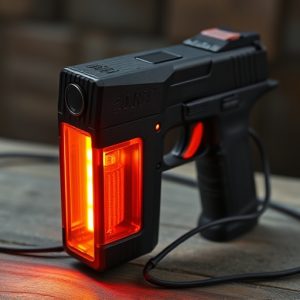Maximizing Efficacy: A Guide to Runt Stun Gun Voltages
A runt stun gun is an effective self-defense device despite its compact size. Its performance is de…….
A runt stun gun is an effective self-defense device despite its compact size. Its performance is determined by factors beyond voltage, including the delivery system and electrode design that can still deliver a potent electrical charge even at potentially lower voltages compared to larger models. These devices typically output between 450,000 to 1,000,000 volts and are effective due to amperage, current type, and pulse duration, in addition to voltage. Users should evaluate these aspects to ensure safety and legal compliance. The effectiveness of a runt stun gun is maximized when targeting the torso or large muscle groups, where the body's higher resistance amplifies its incapacitating effect. Proper training and understanding of local laws are essential for responsible use. Runt stun guns are reliable personal safety tools when users adhere to safety protocols and utilize them correctly as a non-lethal alternative to deter attackers.
When encountering the term “runt stun gun,” one might initially question its efficacy due to its size. However, this compact device packs a surprising punch. In our forthcoming article, we delve into the science and application of runt stun guns, their voltage capabilities, and how these factors influence their defensive potential. From understanding the mechanics behind their operation to learning about safe and effective use, readers will gain insightful knowledge on the efficacy of these personal safety tools. Join us as we explore the often-misunderstood realm of runt stun gun voltage, ensuring you are well-informed about their capabilities for personal defense.
Understanding Runt Stun Gun Voltage: A Comprehensive Guide
When examining the performance of a stun gun referred to as a “runt” model, it’s crucial to consider the voltage output it provides. A stun gun’s voltage is a key factor in determining its effectiveness and the level of incapacitation it can deliver to an assailant. Typically, higher voltage stun guns are associated with more potent electric shocks, which can be disorienting and debilitating for an attacker. However, the term “runt” might lead one to assume that such a device operates at a lower voltage compared to its larger counterparts.
Despite this assumption, the effectiveness of a runt stun gun is not solely dependent on voltage but also on its delivery system and electrode design. These factors work in tandem to ensure that even with potentially lower voltage, the electrical charge is still capable of delivering a powerful and effective shock. The voltage of a runt stun gun can range from moderate to high levels, depending on the manufacturer’s design and intended use case. Users should refer to the specifications provided by the manufacturer for accurate voltage information. It’s also important to understand that a stun gun’s voltage is not the sole determinant of its stopping power; factors like amperage, current type (AC or DC), and the duration of the electrical discharge are equally critical components. When selecting a runt stun gun, it’s advisable to consider these aspects alongside the stated voltage to ensure personal safety and legal compliance with local regulations.
The Mechanics Behind Runt Stun Guns: How Voltage Affects Efficacy
Runt stun guns, despite their compact and less intimidating size compared to their full-sized counterparts, are designed with effectiveness in mind. The efficacy of a stun gun is significantly influenced by its electrical output, which is measured in volts. A stun gun’s voltage determines the intensity of the electric shock it delivers upon activation. Typically, stun guns operate within a range that can incapacitate an attacker by causing neuromuscular involuntary muscle contractions and disorientation. The voltage is a crucial factor in the device’s ability to immobilize an assailant long enough for the user to escape or defend themselves.
The mechanics behind stun guns involve the storage of electrical energy within the device, which is then released through two electrodes when triggered. This high-voltage charge disrupts the normal functioning of the victim’s muscle tissues and nervous system, leading to a loss of balance and motor control. The voltage of a runt stun gun might be lower than that of larger models, but it should still be sufficient for self-defense when deployed correctly. Users must understand that the effectiveness of a stun gun is not solely dependent on its voltage; factors such as proper aiming, correct use, and legal compliance are equally important. It’s also essential to recognize that stun guns are intended as a non-lethal means of self-defense and should be used responsibly within the bounds of the law.
Safe and Effective Use of Runt Stun Guns: Voltage Considerations for Personal Safety
When considering personal safety devices, runt stun guns present a unique option for those in need of a compact yet effective self-defense tool. These devices, despite their smaller form factor compared to their more powerful counterparts, are designed to deliver a high-voltage electric shock that can incapacitate an attacker, thereby ensuring the user’s safety. The effectiveness of a runt stun gun is primarily determined by its voltage output. Typically, these units offer voltage levels ranging from 450,000 to 1,000,000 volts, which are sufficient to deter aggressors without the need for lethal force. It’s crucial for users to understand that the voltage is not the sole factor in the effectiveness of a stun gun; factors such as amperage and electrode design also play significant roles. When deploying a runt stun gun, it’s essential to aim for the torso or larger muscle groups of an assailant, as this will yield the most significant impact due to the body’s higher resistance. Proper training on how to handle and use the device is also paramount, as it ensures that users can confidently rely on their stun gun in self-defense situations. Users should always adhere to local laws and regulations regarding the carry and use of stun guns, as these can vary by jurisdiction. Safety protocols must be followed to avoid accidental discharge and ensure the device is used only for its intended purpose. By understanding the voltage specifications and proper usage techniques, runt stun guns can serve as a reliable self-defense mechanism for personal safety.


